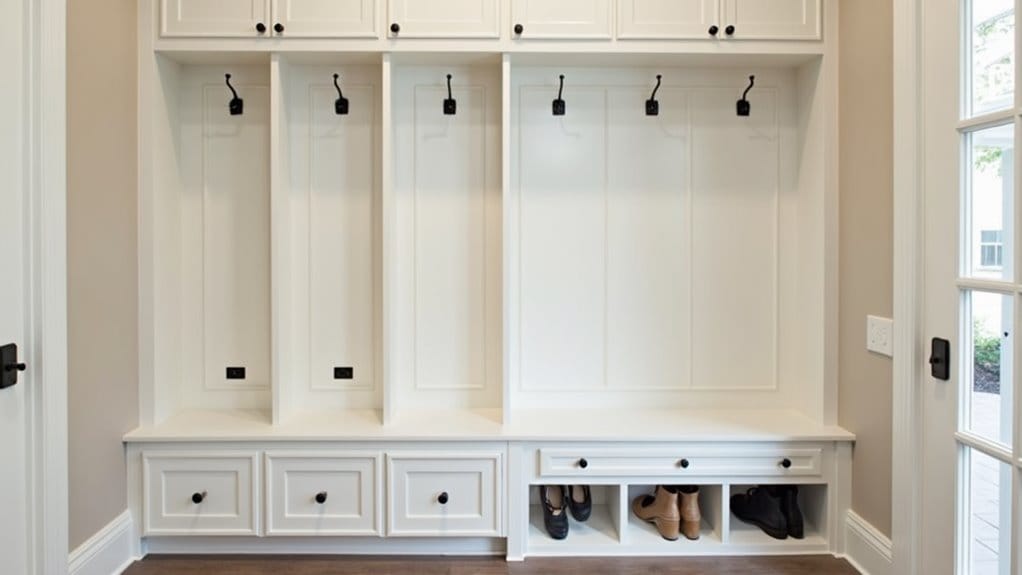A well-organized mudroom can transform your small space into a functional, stylish area where clutter is kept at bay. With thoughtful DIY solutions, you can maximize every inch without sacrificing aesthetics. From clever storage ideas to space-saving accessories, there are countless ways to create a mudroom that works just for you. Curious about the most effective techniques to optimize your tiny entryway? Let’s explore some practical, appealing ideas that make a difference.
Wall-Mounted Hooks and Pegboards
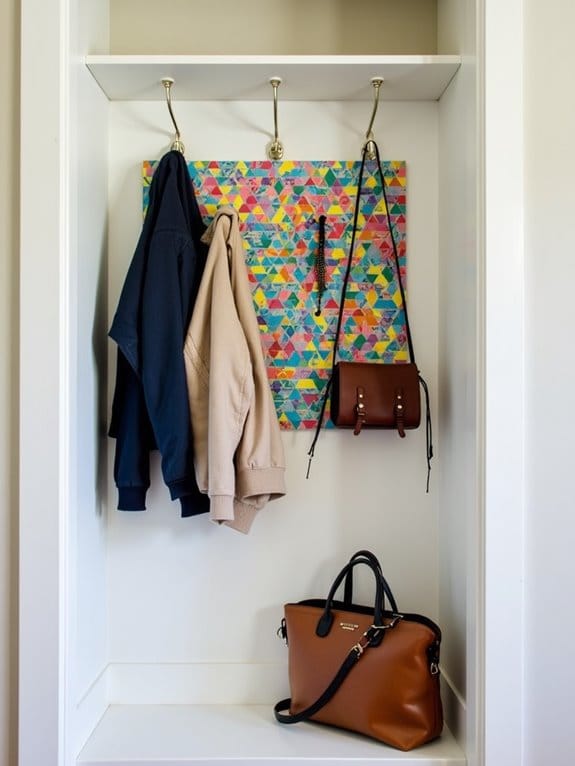
Have you ever considered how wall-mounted hooks and pegboards can transform your mudroom into an organized haven? Imagine sleek, minimalist hooks that seamlessly blend with your decor, providing dedicated spots for jackets, bags, or umbrellas.
A painted or stained pegboard adds visual interest while maximizing vertical space, turning an ordinary wall into a functional art piece. You can customize hook sizes and arrangements, creating a tailored system that suits your needs.
Soft lighting highlights the textures of wood or metal, elevating the aesthetic. This approach keeps clutter at bay, making daily routines smoother.
With thoughtful placement, your mudroom becomes not only practical but also a stylish entry point—an inviting space that merges form with function effortlessly.
Over-the-Door Shoe Organizers
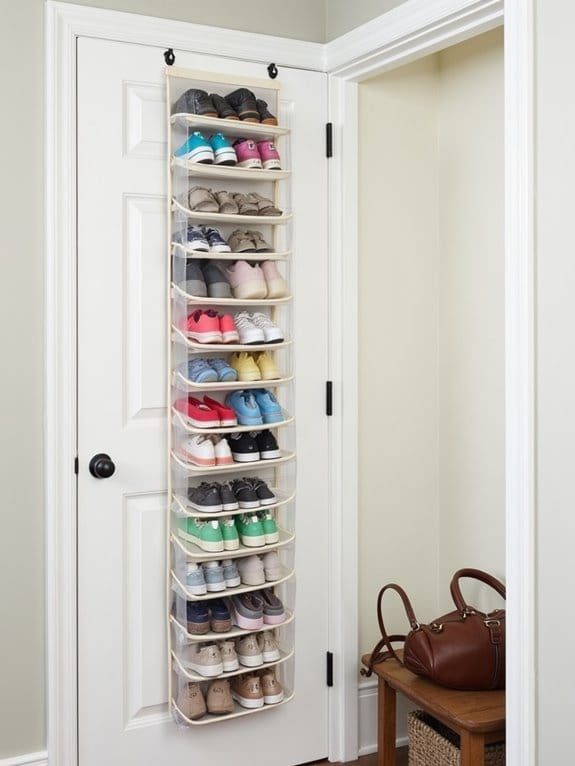
An over-the-door shoe organizer offers a sleek, space-saving solution that keeps footwear neatly arranged and easily accessible. Made from durable fabric or clear plastic, these organizers hang effortlessly over your door, freeing up valuable floor or wall space.
Their multiple pockets provide designated spots for each pair, preventing clutter and making it simple to find the right shoes quickly. Choose a design with breathable materials to prevent odors and guarantee airflow, or opt for transparent pockets to easily identify each pair at a glance.
The aesthetic appeal lies in their minimalist, unobtrusive profile, seamlessly blending into your mudroom’s decor. With a quick installation, you transform a plain door into a functional storage hub that maximizes small spaces while maintaining a tidy, organized look.
Compact Drop Zones With Baskets
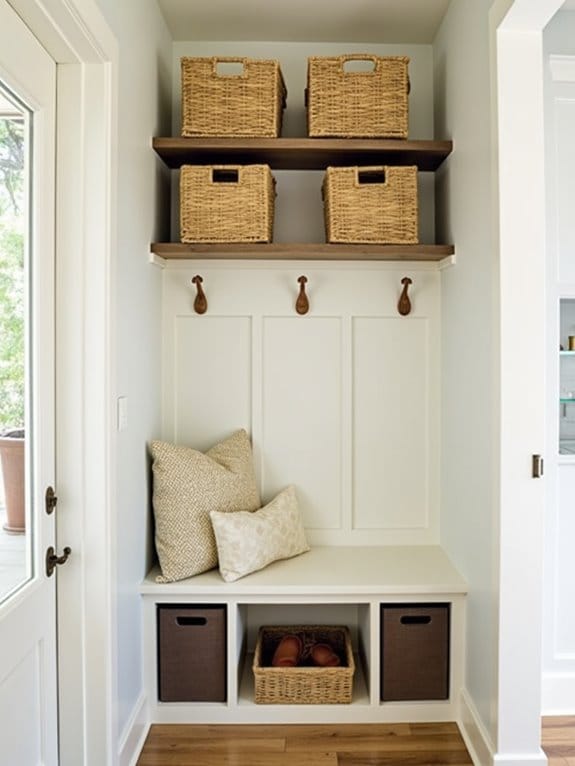
To keep your mudroom effortlessly organized, consider creating a compact drop zone using stylish baskets that fit snugly into available space. Choose baskets made from natural fibers like wicker or woven rattan for an inviting, textured look that complements small spaces.
Stack baskets vertically or nestle them side by side on a narrow shelf or cubby unit, providing designated spots for keys, gloves, hats, and mail. Label each basket with simple tags or chalkboard labels to maintain order at a glance.
This setup minimizes clutter while adding aesthetic appeal, as the uniformity of baskets creates a cohesive, tidy appearance. By dedicating these small, dedicated spaces, you foster efficiency and keep your entryway welcoming and clutter-free.
Space-Saving Wall Shelves
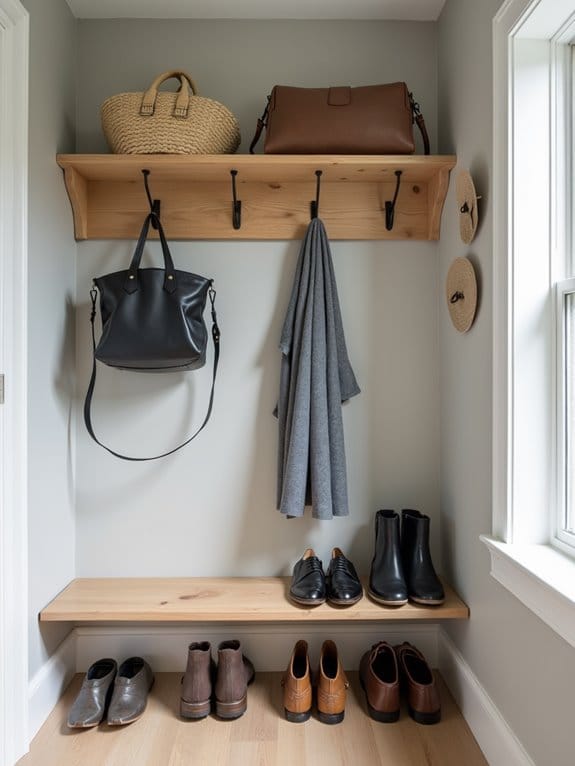
Maximize your entryway’s functionality and style by installing space-saving wall shelves that seamlessly blend into your decor. Choose sleek, narrow shelves that fit snugly above doorways or along narrow walls, providing essential storage without clutter.
Opt for floating shelves with hidden brackets for a clean, modern look, or stagger different sizes for visual interest. Use these shelves to organize shoes, keys, or decorative items like small plants and artwork.
Install hooks beneath or beside the shelves to hang bags or coats, further maximizing vertical space. Select materials that complement your existing decor—natural wood for warmth or painted finishes for a contemporary feel.
With thoughtful placement and simple design, wall shelves help keep your mudroom tidy while enhancing its aesthetic appeal.
Hidden Storage Beneath Benches
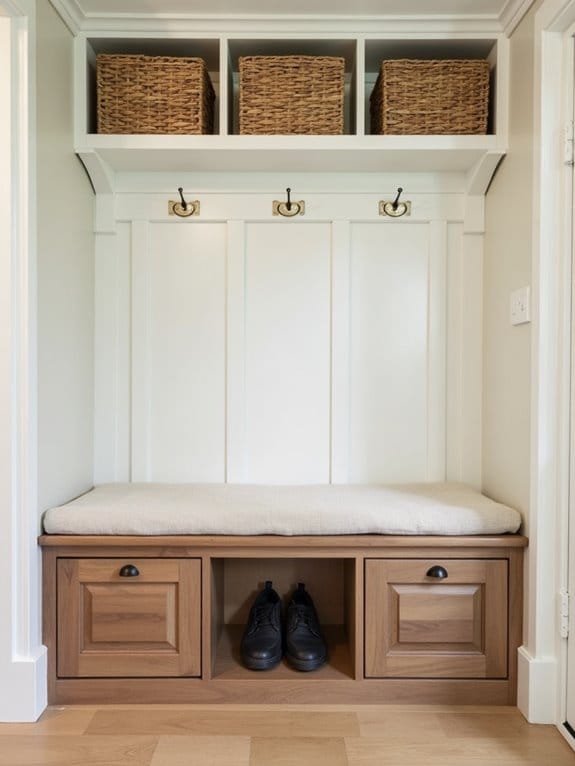
Beneath your mudroom benches lies an untapped opportunity to blend practicality with sleek design. By incorporating hidden storage compartments, you create a seamless look while maximizing space.
Choose a sturdy, attractive bench with a hinge or lift-top lid to access the storage area effortlessly. Inside, you can store shoes, umbrellas, or seasonal gear, keeping clutter out of sight.
To enhance aesthetics, opt for a bench with a finish that complements your decor—whether painted, stained, or natural wood. Add soft-close hinges for quiet access, and consider installing a cushion on top for comfort and style.
This clever solution not only hides away essentials but also contributes to a tidy, inviting entryway that feels organized and thoughtfully designed.
Vertical Storage With Slim Cabinets
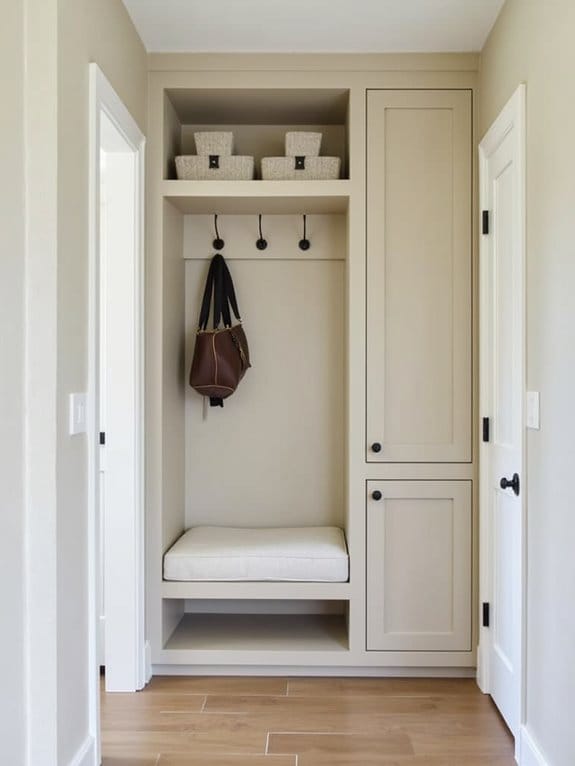
Vertical storage with slim cabinets offers a sleek and efficient way to utilize narrow wall spaces in your mudroom. These cabinets, typically a few inches deep, blend seamlessly into your decor while maximizing storage capacity.
Choose designs with glass fronts for a light, airy feel, or opt for matte finishes for a modern look. Install them at different heights to accommodate various items like shoes, hats, or cleaning supplies, creating a tidy, organized space.
The vertical orientation draws the eye upward, making the room feel taller and less crowded. Use hardware with clean lines and minimal profiles to maintain a streamlined aesthetic.
With thoughtful placement and quality craftsmanship, slim cabinets transform tight corners into functional, stylish storage zones—perfect for small mudrooms.
Use of Modular Cubby Units
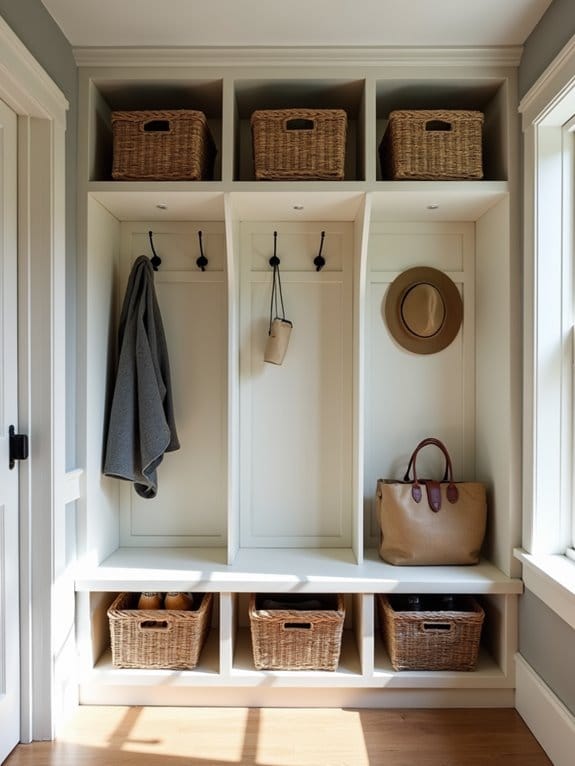
Modular cubby units offer a versatile and visually appealing way to organize your mudroom. Their open design allows you to customize each cubby to fit your needs, whether for shoes, bags, or accessories.
You can choose different sizes and configurations to maximize space and create a cohesive look. The natural wood finish or sleek painted surfaces add warmth and style, blending seamlessly with your décor.
Since they’re lightweight yet sturdy, you can easily rearrange or expand your setup as your storage needs evolve. Incorporating modular cubbies keeps clutter at bay while adding a modern, tidy aesthetic.
Their tidy compartments make it simple to find what you need quickly, making your mudroom both functional and inviting.
DIY Slim Coat Racks
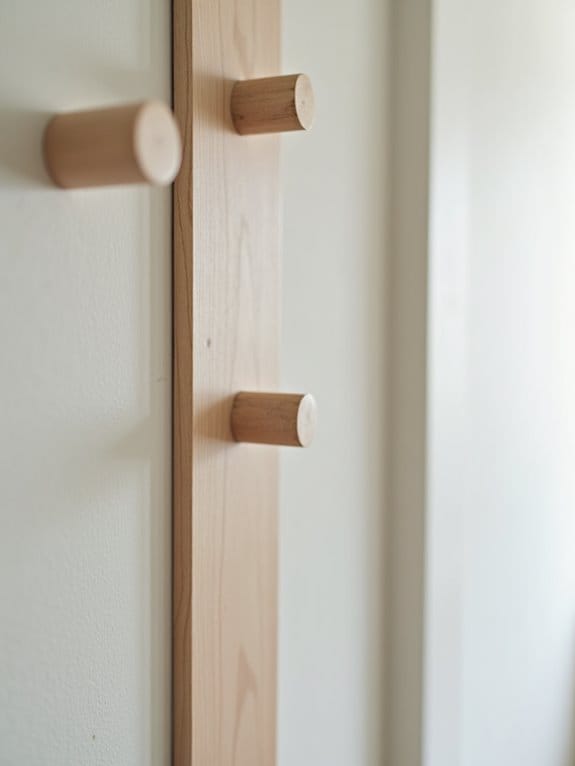
Have you ever struggled to find space for your coats without cluttering your entryway? A DIY slim coat rack is your perfect solution. Craft one from a narrow wooden plank, sanding it smooth for a sleek finish. Attach sturdy hooks evenly spaced along the length—original hooks or vintage knobs add charm.
Mount the rack at a comfortable height, ensuring it doesn’t protrude too far into the space. To elevate its aesthetic, paint it in a neutral tone or a bold accent color that complements your decor. Small, minimalist hooks keep things tidy, while a narrow design maximizes vertical storage without sacrificing floor space.
This custom coat rack offers a stylish, functional touch that keeps your coats organized and your entryway open and inviting.
Repurposing Mudroom Nooks
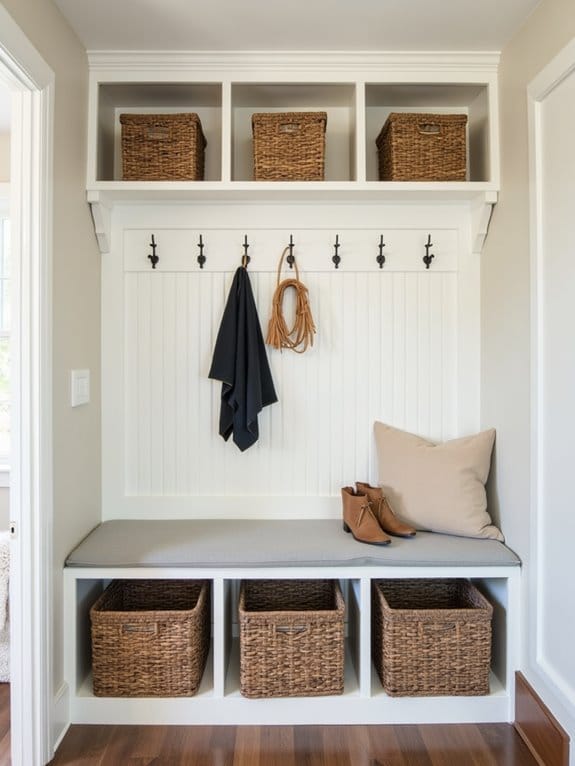
When you transform an underutilized mudroom nook, you can turn an awkward corner into a charming, functional space. Start by cleaning and painting the walls a bright, inviting hue to make the nook feel more spacious.
Add a narrow console or floating shelves to create a dedicated spot for keys, mail, and small accessories. Incorporate hooks or pegs for coats, hats, and bags, keeping clutter off the floor.
Consider installing a slim storage bench with hidden compartments for shoes or seasonal gear. Personalize the space with decorative touches like a small mirror, a cheerful rug, or framed artwork.
This repurposed nook becomes an efficient entryway station, blending practicality with style, and maximizes every inch without overwhelming your small space.
Installing Fold-Down Seating With Storage
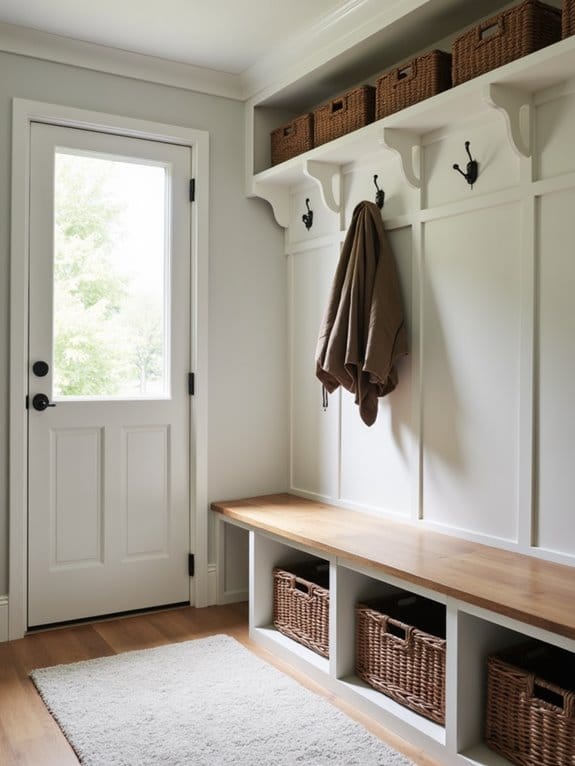
Adding fold-down seating with built-in storage transforms your mudroom into a sleek, multifunctional space that balances comfort and organization. Choose a sturdy, attractive hinge system that allows the seat to fold flat against the wall when not in use.
Select a material for the seat that complements your decor—warm wood, painted MDF, or cushioned fabric. Underneath, install storage compartments or cubbies to hold shoes, umbrellas, or seasonal gear, maximizing every inch of space.
Secure the seat to wall studs for stability, ensuring it can support weight comfortably. Keep the design minimalist with clean lines and smooth finishes, so it blends seamlessly into your small space.
This setup provides a cozy spot to sit while organizing essentials, without sacrificing valuable floor area.
Multi-Functional Furniture Pieces
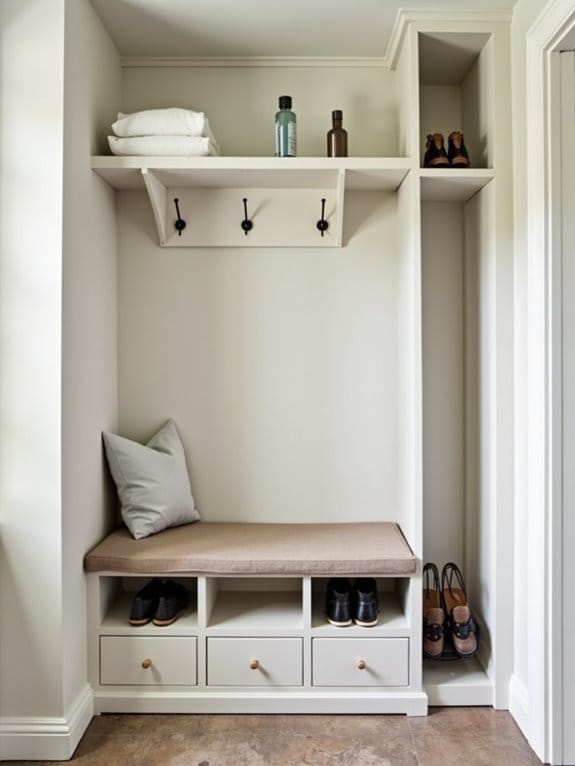
Multi-functional furniture pieces serve as the backbone of an efficient mudroom, seamlessly combining style and practicality. Imagine a sleek bench that doubles as hidden storage, providing a comfortable spot to sit while concealing shoes, boots, or seasonal gear beneath a cushioned top.
Wall-mounted units with integrated hooks and shelves maximize vertical space, keeping clutter off the floor. Consider a compact console table with drawers for keys, mail, and accessories, topped with a decorative tray to tie the space together.
These versatile pieces not only save space but elevate your mudroom’s aesthetic, blending functionality with design. By choosing furniture that serves multiple purposes, you create an organized, inviting entryway without sacrificing style or space.
Creative Use of Under-Stair Spaces
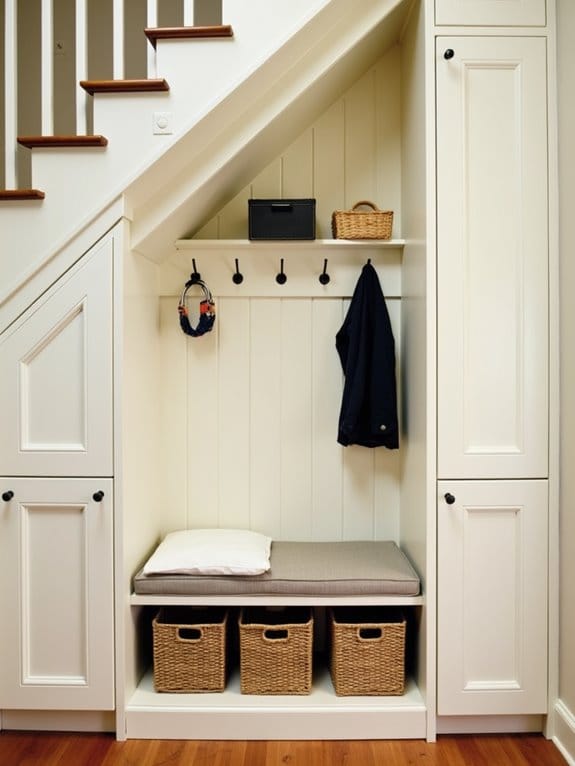
Under-stair spaces offer a hidden opportunity to enhance your mudroom’s functionality and visual appeal. You can transform this often-overlooked nook into a sleek storage solution by installing custom shelving or cubbies.
Think about adding woven baskets or decorative boxes to keep shoes, hats, and gloves organized, while maintaining a tidy look. For a more polished finish, consider painting or wallpapering the interior for a pop of color or pattern.
You might also incorporate a small bench with built-in storage, providing both seating and a place to stash essentials. Adding hooks or pegs on the side walls maximizes vertical space for coats and bags.
This clever use of under-stair space not only declutters your mudroom but also creates an inviting, organized entryway that feels thoughtfully designed.
Magnetic Strips for Small Items
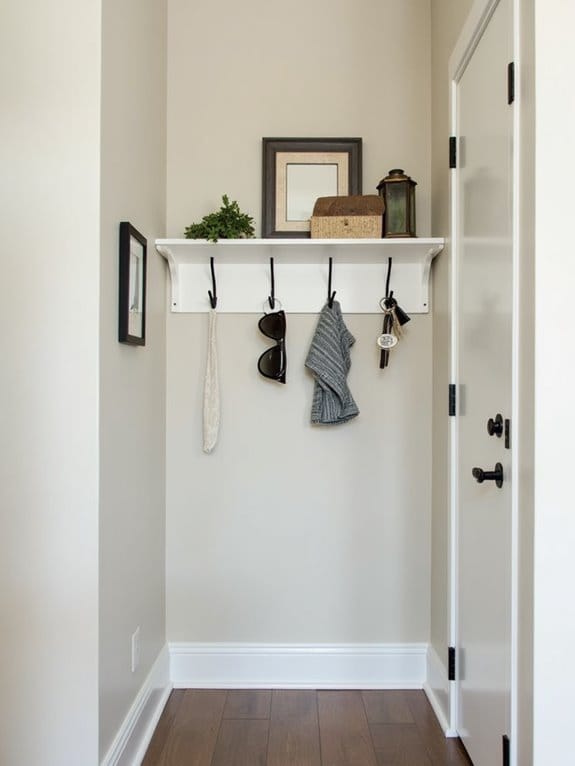
Magnetic strips offer an elegant solution for organizing small metal items in your mudroom, keeping essentials within easy reach while maintaining a sleek appearance. You can install a slim strip along a wall or inside a cabinet door, providing a dedicated space for keys, scissors, or metal jewelry.
Choose a strip with a strong magnet to securely hold items without slipping. Select a finish that complements your decor—brushed nickel, matte black, or stainless steel—to enhance the aesthetic.
Keep it clutter-free by designating specific zones for different items. This simple yet effective setup saves counter space and prevents small objects from getting lost in drawers or on cluttered surfaces.
With minimal effort, magnetic strips blend functionality and style seamlessly in your small mudroom.
Hanging Baskets for Accessories
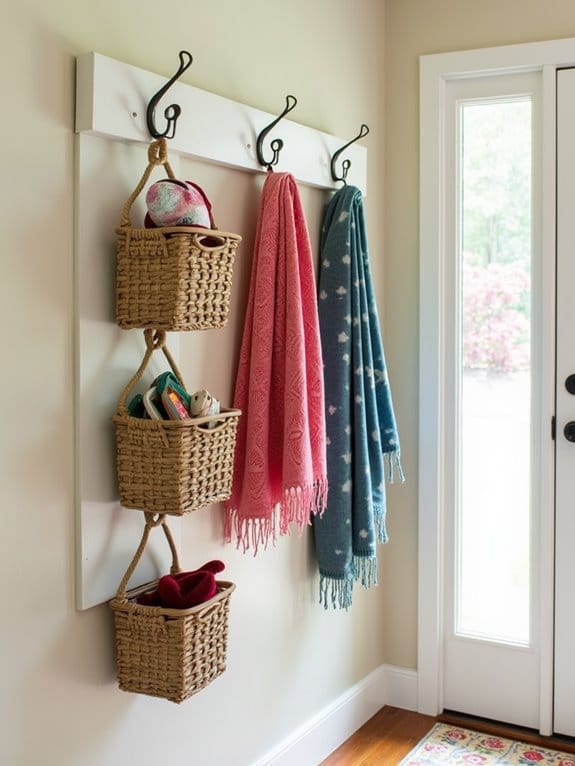
Hanging baskets provide a charming and practical way to organize accessories in your mudroom, turning often cluttered spaces into tidy displays. You can choose woven or wire baskets that hang from hooks or rods, adding texture and visual interest. Use them for sunglasses, scarves, gloves, or small bags, keeping everything within easy reach.
Position baskets at eye level or near the entrance to maximize accessibility without sacrificing space. Arrange multiple baskets vertically or horizontally, creating a layered look that adds depth to your area. Clear containers or baskets with labels help you quickly find what you need, while decorative touches like ribbons or paint personalize your setup.
With hanging baskets, your accessories stay organized, visible, and stylish—perfect for small mudroom spaces.
Utilizing Corner Spaces Effectively
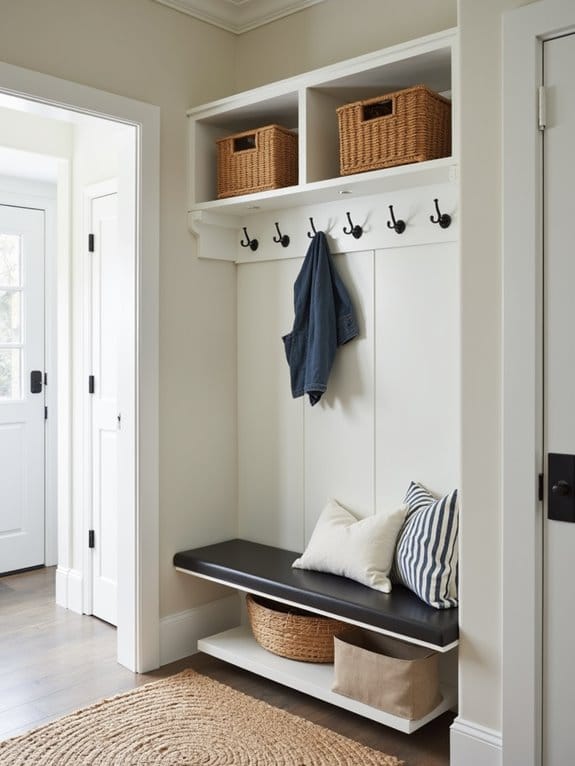
Corners often go overlooked in mudroom designs, yet they offer valuable space that can be transformed into functional and stylish storage solutions. To maximize this area, consider installing corner shelves or lazy Susans, which provide easy access to shoes, hats, or small accessories.
Corner benches with built-in cubbies create a cozy sitting area while offering hidden storage for boots, umbrellas, or bags. You can also add vertical storage units that fit snugly into corner nooks, keeping clutter off the floor.
Use decorative baskets or woven bins to add texture and visual interest, ensuring the space remains inviting. By thoughtfully customizing corner spaces, you turn awkward gaps into efficient, visually appealing zones that optimize every inch of your small mudroom.
DIY Magnetic or Pegboard Organizer Boards
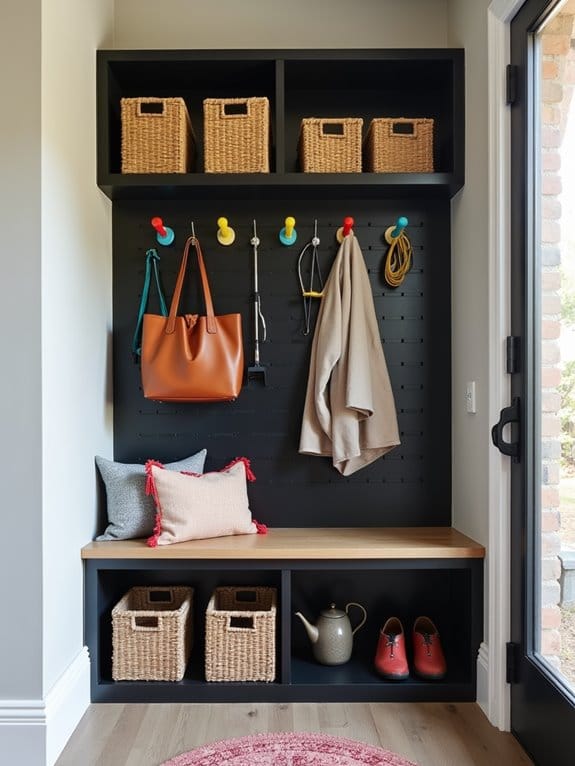
Transforming an empty wall into a functional, eye-catching organizer can dramatically improve your mudroom’s efficiency and style. A DIY magnetic or pegboard organizer offers a sleek, customizable solution that maximizes vertical space.
Choose a durable pegboard or magnetic board, cut it to size, and secure it to your wall with sturdy brackets or screws. You can paint or decorate it to match your decor, creating a cohesive look.
Add hooks, baskets, or small shelves to hold keys, mail, hats, or scarves, keeping clutter off surfaces. This setup not only keeps essentials within easy reach but also adds an element of visual interest.
With a little effort, your wall becomes a versatile, organized space that’s both practical and charming.


